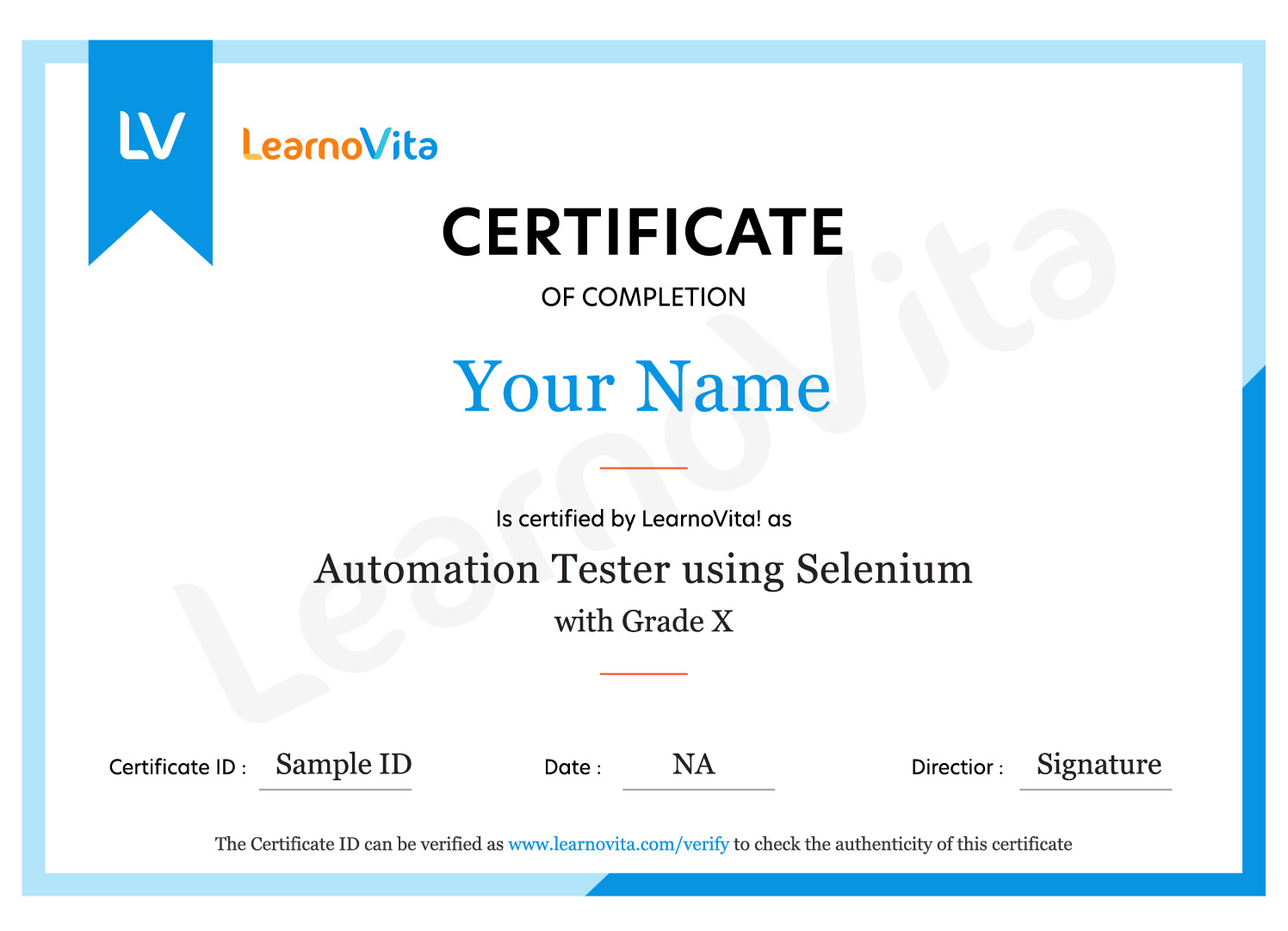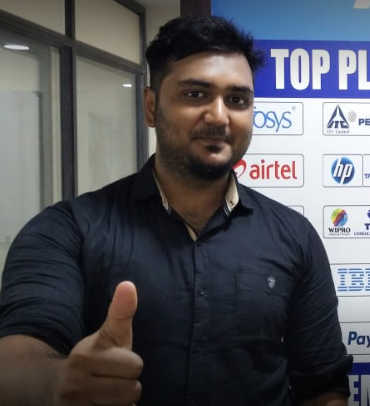What You'll Learn
Full Stack Developer Course in Maraimalainagar in end-to-end web development, thoroughly understand client and server technologies.
Discover how to create dynamic websites by working through real-world coding challenges and interactive seminars.
Develop state-of-the-art applications with full-stack expertise by utilizing tools such as Express, MongoDB, and Angular.
Learn about source control, performance tuning techniques, and deployment procedures.
Students who complete Full Stack Developer Training in Maraimalainagar gain real-world experience and information that is pertinent to the industry.
Obtain certification and enhance your CV with expert help and practical project experience.
Full Stack Developer Training Objectives
- A Full Stack developer is in charge of both front-end and back-end web development. A good full stack developer will typically understand how to work with a variety of languages and databases, including PHP, HTML, CSS, JavaScript, and everything in between.
- Full-stack web developers understand HTML, CSS, JavaScript, and one or more back-end languages. Most full stack developers specialize in a single back-end programming language, such as Ruby, PHP, or Python, though some, especially if they've been working as a developer for a while, work with multiple languages.
- According to Glassdoor, the average salary for full-stack developers in India is INR 9.24 LPA. At its lowest point, this figure can drop to INR 4.69 LPA, while an experienced professional can earn up to INR 16.88 LPA.
- A full stack engineer should be familiar with at least one server-side programming language such as Java, Python, Ruby,.Net, and so on. Another important requirement for a full stack developer is knowledge of various DBMS technologies. MySQL, MongoDB, Oracle, and SQLServer are popular choices for this purpose.
- A full stack web developer can create both client and server software. He/she knows how to: in addition to HTML and CSS, he/she also knows how to: Create a browser (like using JavaScript, jQuery, Angular, or Vue) Create a server (like using PHP, ASP, Python, or Node).
- You'll be relieved to learn that full-stack development jobs are among the highest-paying jobs in India. This is primarily due to high demand and a scarcity of skilled professionals in this field. A full-stack developer in India earns INR 9.24 LPA on average.
- Hire Google Developers and Programmers. Full Stack Web Developer with a strong passion for Javascript, Ruby, Python, and their various libraries, frameworks, and best practices.
- Full Stack Web Developers are in high demand, and it will continue to rise in the coming years. Another eye-opening statistic is that the number of Full Stack Development jobs available will increase from 135,000 to more than 853,000 by 2024. (U.S. Bureau of Labor Statistics).
Following a few simple steps, you can become a full-stack developer, such as:
- Learn the required programming languages.
- Hone your skills.
- Become acquainted with all technologies, but a master of only one.
- Enroll in a course.
- Gain practical experience.
- Take on additional responsibilities.
- Design your own website.
- Make use of GitHub.
- Set up accounts on freelance websites and look for clients.
Request more informations
Phone (For Voice Call):
+91 89258 75257
WhatsApp (For Call & Chat):
+91 89258 75257
Full Stack Developer Course Benefits
The Full Stack Developer Certification Course in Maraimalainagar offers thorough education in web development technologies, including frontend and backend frameworks, under the supervision of a specialist. As Full Stack Developer Internship in Maraimalainagar students have access to internship options that bridge the gap between classroom learning and Full Stack Developer Projects in Maraimalainagar.
- Designation
-
Annual SalaryHiring Companies
About Your Full Stack Developer Certification Training
An affordable method of mastering both basic and advanced web development technologies, such JavaScript, React, and Node.js, is to enroll in the Full Stack Developer Certification course. In addition to providing students with hands-on training, Full Stack Developer rates are meant to be reasonable. Our Full Stack Developer Training in Maraimalainagar provides Full Stack Developer Course With Placement by putting you in touch with top recruitment firms.
Top Skills You Will Gain
- HTML Basics
- CSS Styling
- JavaScript Fundamentals
- Responsive Design
- API Integration
- Database Handling
- Server Programming
- Version Control
12+ Full Stack Developer Tools
Online Classroom Batches Preferred
No Interest Financing start at ₹ 5000 / month
Corporate Training
- Customized Learning
- Enterprise Grade Learning Management System (LMS)
- 24x7 Support
- Enterprise Grade Reporting
Why Full Stack Developer Course From Learnovita ? 100% Money Back Guarantee
Full Stack Developer Course Curriculam
Trainers Profile
Full Stack course will enable you to build interactive and responsive web applications using both front-end and back-end technologies . The position of full stack developer is the high-profile job prevailing in the IT industry . Our Trainers are Experts in Blue Prism who has 11+ Years industry Experienced .
Syllabus of Full Stack Developer Course Download syllabus
- HTML5 Structure
- Semantic Tags
- CSS3 Styling
- Box Model
- Flexbox & Grid
- Data Types & Variables
- Functions & Scope
- DOM Manipulation
- Event Handling
- ES6+ Features
- Introduction to React.js
- Components & Props
- State Management
- Hooks Overview
- Routing with React Router
- Node.js Setup & Architecture
- Modules & Packages (npm)
- File System & Streams
- Express.js Framework Basics
- Middleware Functions
- Introduction to NoSQL & SQL
- CRUD Operations
- MongoDB Setup & Queries
- Mongoose ORM
- MySQL Basics
- REST API Concepts
- Building APIs with Express.js
- Request & Response Handling
- Authentication & Authorization Basics
- Error Handling in APIs
- Git Fundamentals
- Branching & Merging
- Remote Repositories (GitHub)
- Pull Requests & Code Reviews
- Resolving Conflicts
- Introduction to Web Hosting
- Deploying Node.js Applications
- Using Platforms like Heroku
- Environment Variables
- Basic Linux Commands for Deployment
- Closures & Scope Chains
- Prototypes & Inheritance
- Event Bubbling & Capturing
- Modules in JavaScript
- Memory Management
- Debugging with Browser DevTools
- Unit Testing with Jest
- Integration Testing Basics
- Writing Test Cases
- Debugging Node.js Applications
Request more informations
Phone (For Voice Call):
+91 89258 75257
WhatsApp (For Call & Chat):
+91 89258 75257
Industry Projects
Career Support
Our Hiring Partner
Request more informations
Phone (For Voice Call):
+91 89258 75257
WhatsApp (For Call & Chat):
+91 89258 75257
Exam & Full Stack Developer Certification
At LearnoVita, You Can Enroll in Either the instructor-led Full Stack Online Course, Classroom Training or Online Self-Paced Training.
Full Stack Online Training / Class Room:
- Participate and Complete One batch of Full Stack Training Course
- Successful completion and evaluation of any one of the given projects
Full Stack Online Self-learning:
- Complete 85% of the Full Stack Certification Training
- Successful completion and evaluation of any one of the given projects
This is the Kind of Certification levels that was Structured under the Full Stack Certification Path.
- LearnoVita Full Stack Developer Certification
- Learn About the Certification Paths.
- Write Code Daily This will help you develop Coding Reading and Writing ability.
- Refer and Read Recommended Books Depending on Which Exam you are Going to Take up.
- Join LernoVita Full Stack Certification Training in Chennai That Gives you a High Chance to interact with your Subject Expert Instructors and fellow Aspirants Preparing for Certifications.
- Solve Sample Tests that would help you to Increase the Speed needed for attempting the exam and also helps for Agile Thinking.

Our Student Successful Story
How are the Full Stack Developer Course with LearnoVita Different?
Feature
LearnoVita
Other Institutes
Affordable Fees
Competitive Pricing With Flexible Payment Options.
Higher Full Stack Developer Fees With Limited Payment Options.
Live Class From ( Industry Expert)
Well Experienced Trainer From a Relevant Field With Practical Full Stack Developer Training
Theoretical Class With Limited Practical
Updated Syllabus
Updated and Industry-relevant Full Stack Developer Course Curriculum With Hands-on Learning.
Outdated Curriculum With Limited Practical Training.
Hands-on projects
Real-world Full Stack Developer Projects With Live Case Studies and Collaboration With Companies.
Basic Projects With Limited Real-world Application.
Certification
Industry-recognized Full Stack Developer Certifications With Global Validity.
Basic Full Stack Developer Certifications With Limited Recognition.
Placement Support
Strong Placement Support With Tie-ups With Top Companies and Mock Interviews.
Basic Placement Support
Industry Partnerships
Strong Ties With Top Tech Companies for Internships and Placements
No Partnerships, Limited Opportunities
Batch Size
Small Batch Sizes for Personalized Attention.
Large Batch Sizes With Limited Individual Focus.
Additional Features
Lifetime Access to Full Stack Developer Course Materials, Alumni Network, and Hackathons.
No Additional Features or Perks.
Training Support
Dedicated Mentors, 24/7 Doubt Resolution, and Personalized Guidance.
Limited Mentor Support and No After-hours Assistance.
Full Stack Developer Course FAQ's
- LearnoVita is dedicated to assisting job seekers in seeking, connecting, and achieving success, while also ensuring employers are delighted with the ideal candidates.
- Upon successful completion of a career course with LearnoVita, you may qualify for job placement assistance. We offer 100% placement assistance and maintain strong relationships with over 650 top MNCs.
- Our Placement Cell aids students in securing interviews with major companies such as Oracle, HP, Wipro, Accenture, Google, IBM, Tech Mahindra, Amazon, CTS, TCS, Sports One , Infosys, MindTree, and MPhasis, among others.
- LearnoVita has a legendary reputation for placing students, as evidenced by our Placed Students' List on our website. Last year alone, over 5400 students were placed in India and globally.
- We conduct development sessions, including mock interviews and presentation skills training, to prepare students for challenging interview situations with confidence. With an 85% placement record, our Placement Cell continues to support you until you secure a position with a better MNC.
- Please visit your student's portal for free access to job openings, study materials, videos, recorded sections, and top MNC interview questions.

- Build a Powerful Resume for Career Success
- Get Trainer Tips to Clear Interviews
- Practice with Experts: Mock Interviews for Success
- Crack Interviews & Land Your Dream Job
Get Our App Now!

















 Regular 1:1 Mentorship From Industry Experts
Regular 1:1 Mentorship From Industry Experts





